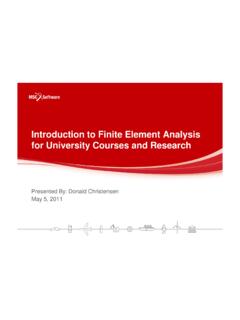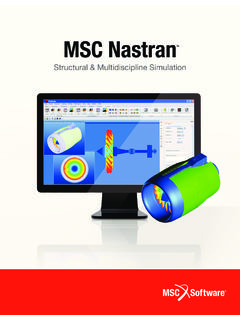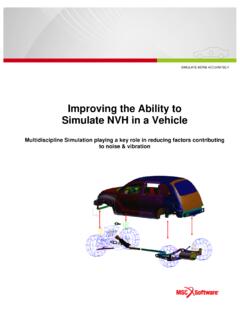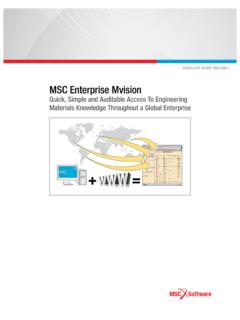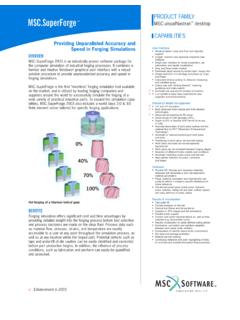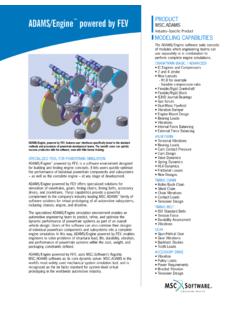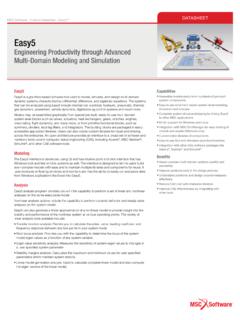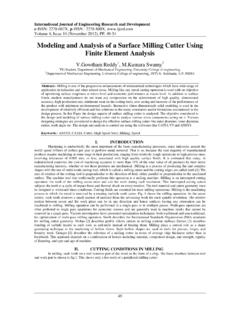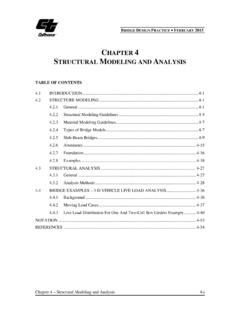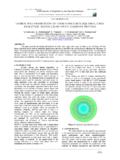Transcription of Technical Paper - MSC Software Corporation
1 NONLINEAR finite ELEMENT ANALYSIS OF ELASTOMERST echnical Corporation , the worldwide leader in rubber analysis,would like to share some of ourexperiences and expertise in analyzingelastomers with White Paper introduces you to thenonlinear finite element analysis (FEA) of rubber-like polymers generally groupedunder the name elastomers. You mayhave a nonlinear rubber problem andnot even know Paper is primarily intended for twotypes of readers:ENGINEERING MANAGERSwho areinvolved in manufacturing of elastomericcomponents, but do not currently possessnonlinear FEA tools, or who may have aneducational/professional backgroundother than mechanical ENGINEERSwho are perhaps familiar with linear, or even nonlinear,FEA concepts, but would like to knowmore about analyzing is assumed that the reader is familiarwith basic principles in strength ofmaterials White Paper is a complement s White Paper onNonlinear FEA.
2 Which introduces thereader to nonlinear FEA methods and alsoincludes metal forming contents of this White Paper areintentionally organized for theconvenience of these two kinds of readers. For an Engineering Manager, topics ofinterest include an Executive Summaryto get an overview of the subject, the CaseStudiesto see some real-world rubber FEAapplications, and any other industryspecific Design Engineer, on the otherhand, can examine the significantfeatures on analysis of elastomers (whichconstitute the bulk of the Paper ). TheAppendicesdescribe the physics andmechanical properties of rubber, propermodeling of incompressibility in rubberFEA, and most importantly, testingmethods for determination of materialproperties.
3 Simulation issues and usefulhints are found throughout the text andin the Case FEA is an extensive subject, whichinvolves rubber chemistry, manufacturingprocesses, material characterization, finiteelement theory, and the latest advances incomputational mechanics. A selected listof Suggestions for Further Readingisincluded. These references cite some ofthe most recent research on FEA ofelastomers and demonstrate practicalapplications. They are categorized bysubject for the reader s the CoverThe cover shows a photorealistic rendition of the strain energy density on the deformedconfiguration of a rubber constant velocity automotive boot. One can observe the hiddenportion of the bellows in the reflections on the visible Summary32 Material Time-Independent Nonlinear Other Polymeric Materials183 Automatic Determination of Material Parameters from Test Data214 Damage and Failure245 Dynamics, Vibrations, and Acoustics256 Automated Contact Analysis Techniques297 Automated Solution Strategies328 Automated Remeshing and Rezoning349 Current Trends and Future Research3610 User Conveniences and Services3711 Conclusion39 CASESTUDIESAO-Ring Under Compression9 BCar Tire14 CConstant-Velocity Rubber Boot Compression and Bending20 DRubber Mount28 ECar Door Seal.
4 Automated Multibody Contact31 APPENDICESAP hysics of Rubber40 BNumerical Treatment of Incompressibility42 CMaterial Testing Methods44 DAnswers to Commonly Asked Questions in Rubber Product Design56 SUGGESTIONS white Paper discussesthe salient featuresregarding the mechanicsand finite elementanalysis (FEA) ofelastomers. Although themain focus of the Paper ison elastomers (or rubber-like materials) and foams,many of these conceptsare also applicable to the FEA of glass, plastics, andbiomaterials. Therefore, this White Paper should beof value not only to the rubber and tire industries,but also to those involved in the following: Glass, plastics,ceramic, and solidpropellant industries Biomechanics and themedical/dentalprofessions implantablesurgery devices,prostheses, orthopedics,orthodontics, dentalimplants, artificial limbs,artificial organs,wheelchairs and beds, monitoring equipment Highway safety and flight safety seat beltdesign, impact analysis, seat and padding design,passenger protection Packaging industry Sports and consumerindustries helmetdesign, shoe design,athletic protection gear,sports equipment are usedextensively in manyindustries because of theirwide availability and low cost.
5 They are also usedbecause of their excellent damping and energyabsorption characteristics, flexibility, resiliency,long service life, ability to seal against moisture,heat, and pressure, non-toxic properties,moldability, and variable is a very unique processing and shaping, itbehaves mostly like a highlyviscous fluid. After its polymerchains have been crosslinked byvulcanization (or by curing),rubber can undergo large reversibleelastic deformations. Unlessdamage occurs, it will return to itsoriginal shapeafter removal of the analysis of rubbercomponents requires specialmaterial modeling and nonlinearfinite elementanalysis tools thatare quite differentthan those used formetallic parts.
6 Theunique properties ofrubber are such that:1. It can undergo largedeformationsunder load,sustaining strains of up to 500percent inengineering Its load-extension behavior ismarkedly Because it isviscoelastic, itexhibitssignificantdampingproperties. Itsbehavior is time-and temperature-dependent,making it similar to glass andplastics in this It is nearly means its volume does notchange appreciably with stress. Itcannot be compressed significantlyunder hydrostatic certain foam rubber materials, the assumptionof near incompressibility is relaxed, since largevolume change can be achieved by the applicationof relatively moderate MOUNTCAR TIREO-RINGCAR DOOR SEALRUBBER BOOTSECTIONEXECUTIVESUMMARY14 The nonlinear FEA program, (Marc)possesses specially-formulated elements , material andfriction models, and automated contact analysisprocedures to model elastomers.
7 Capabilities anduniqueness of Marc in analyzing large, industry-scaleproblems are highlighted throughout this White and realistic analysis for design of elastomeric products relies on several importantconcepts outlined below:1. Nonlinear material behavior compressible or incompressible materialmodels, time and temperature effects, presence of anisotropy due to fillers or fibers,hysteresis due to cyclic loading andmanifestation of Automaticdetermination ofmaterial parametersfrom test data perhaps the single mosttroublesome step for mostengineers in analyzingelastomers; that is, how to "curve fit" test data and deriveparameters necessary to characterize Failure causes andanalysis of failure resulting due to material damage and degradation, cracking, and Dynamics shock and vibration isolationconcerns, damping, harmonic analysis ofviscoelastic materials, time versus frequencydomain viscoelastic analysis, and implicitversus explicit direct time integration Modern automated contact analysistechniques friction effects, and the use of contact bodies to handle boundary conditionsat an Automated solution strategies issuesrelated to model preparation, nonlinearanalysis.
8 Parallelization and ease-of-use of thesimulation AutomatedRemeshing andRezoning- foreffective solution ofproblems involvingheavily distortedmeshes which can lead to premature terminationof offers a well-balanced combination ofsophisticated analysis code integrated seamlessly witheasy-to-use Graphical User Interface (GUI) and increasingly with , for thesimulation of elastomeric products. This makes Marcuniquely suitable for the simulation of complex physicsof rubber, foam,plastics, andbiomaterials. Thefollowing sectionsbriefly explains the insides of anonlinear FEA code(and its differencesfrom a linear FEAprogram) along withthe accompanyingGUI finite element method is a computer-aidedengineering technique for obtaining approximatenumerical solutions to boundary value problemswhich predict the response of physical systemssubjected to external loads.
9 It is based on theprinciple of virtual work. One approximation methodis the so-called weighted residuals method, the mostpopular example of which is the Galerkin method(see any of the finite element texts listed in theSuggestions for Further Readingsection at theback). A structure is idealized as many small, discretepieces called finite elements , which are connected atnodes. In finite element analysis, thousands ofsimultaneous equations are typically solved using computers. Instructural analysis,the unknowns arethe nodal degrees offreedom, likedisplacements,rotations, or thehydrostratic OFNONLINEAR ANDRUBBERFEAA recent National Research Council report oncomputational mechanics research needs in the 1990s[Oden, 1991]
10 Emphasized that the materials field is anational critical technology for the United States, andthat areas such as damage, crack initiation andpropagation, nonlinear analysis, and coupled fieldproblems still require extensive embarking on the issues related to the materialbehavior, it is interesting to review how the finiteelement method has matured in the past sixtyyears paying special attention to recent improvementsin nonlinear FEA techniques for handling rubber contact problems:1943 Applied mathematician Courant used triangularelements to solve a torsion and Synge used triangular elements to solve a 2-D elasticity problem using the hypercircle method.
